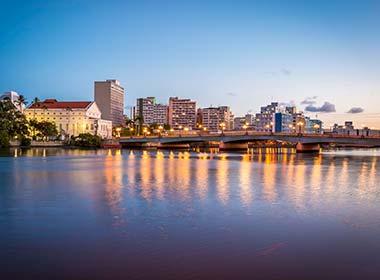Recife, Brazil’s fifth largest city is located along the northern coast. This vibrant city has the old colonial charm, city vibe and laid back beach culture. Bridges and canals connect this city surrounded by water- hence known as “Venice of Brazil.”
Visitors shouldn’t bypass the historical sites, art, beaches and of course, football of Recife.

History
Founded by the Portuguese in the 16th century and conquered briefly by the Dutch from 1630-1654, Recife offers visitors a glimpse into the past left behind by the Portuguese and the Dutch. Take a tour to Olinda, a UNESCO heritage site and a living museum of Brazil. Original and renovated Baroque churches, gardens, forts and small passos frame the historical part of the city.
Climb to the highest point to Alto da Sé, Olinda’s must-see place and visit other remarkable colonial buildings like the Church of Graça, Convent do Carmo and Episcopal Palace. In recent years Olinda has been also known as a city of art.
Beach
Relax and chill in a beach chair in Recife’s trendy beach neighborhood of Boa Viagem. This area is relatively safe with eight kilometers of sand, palm trees, dunes and high-rise buildings.
Many consider Boa Viagem a great place for nightlife and restaurants. Restaurants serve beer, regional food and lots of fish, shrimp and crab. Besides restaurants, the local vendors offer the real taste of Brazilian delicacies and drinks at a cheaper price.
Shark warning signs do appear at Boa Viagem.

Culture and local crafts
Casa de Cultura is housed in an old prison built during the late 1840s. The old cells have been transformed into 150 craft shops, footstalls, bookshops and galleries. The outdoor patio is now an area for folklore, concerts and a food court. Casa de Cultura is the largest cultural and art center of the district of Pernambucana.
Most of the crafts are from the locals in the region. Locals and visitors alike will find unique pieces of clay or ceramic dolls, chess sets, angels and sacred images. Also, leather handbags and sandals, hats, linen, renaissance laces, native woodcrafts, embroidered shirts and more.

Festival, dance and music
To understand Brazilian culture one has to check out the festivals, dance and music. African and Portuguese cultural roots are found in the dance, music and Folclore Nordestino festival. The Folclore Nordestino festival is in the month of August.
Music lovers must visit Paço do Frevo for forró and other local music inspired by local musicians including Luiz Gonzaga, Brazilian’s most influential musician. Check out the maracatu dance, a type of Afro-Brazilian dance movement.
For a taste of Brazilian northeast and Recife, speak to the Tucan Travel Tailor-made team.
About the Author: Claudia is a New York based copywriter, traveller and wine enthusiast. She has travelled independently and on group tours with her family through South America with Tucan Travel. You can find her on Google+ or read her other contributions here. You can find her at www.travelwritingpro.com.
Spread the love



